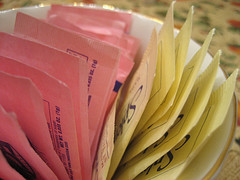 Alternative names for sweeteners include: sugar, sugar substitutes, and artificial sweeteners. In fact, there are two kinds of sweeteners:
Alternative names for sweeteners include: sugar, sugar substitutes, and artificial sweeteners. In fact, there are two kinds of sweeteners:
- Nutritive sweeteners supply calories and energy to the body. Like sugar, they have 4 calories per gram. Examples include honey and corn syrup.
- Non-nutritive sweeteners are called sugar substitutes. They have no calories and provide no energy to the body. Most do not break down in the body as sugar does, but simply leave the body in the urine. Examples include aspartame and saccharin.
What food source is the nutrient found in? Some sweeteners are found naturally in fruits such as grapefruit, and in vegetables such as sugar beets. Others are man-made.
How does the nutrient affect the body? Nutritive sweeteners include sugar and sugar alcohols. Nutritive sweeteners make foods taste sweet. They also enhance moisture, tenderness, and the "mouth feel" of food, especially baked goods. These sweeteners can preserve some foods, which improves flavor and freshness.
Non-nutritive sweeteners provide sweetness without calories. Most non-nutritive sweeteners do not improve the moisture or tenderness of baked goods.
Nutritive Sweeteners: All nutritive sweeteners, except sugars found in alcohol, provide 4 calories per gram, which is 16 calories per teaspoon. Compared with fat, which has 9 calories per gram, sugars, like other carbohydrates, are lower in calories. When people eat too many sugary foods, however, they may still gain weight.
The average American eats 20 teaspoons of sugar per day. People often are not aware they are eating so much sugar. Government guidelines recommend eating much smaller amounts of sugar and sugary foods. Fatty foods and sweets appear at the top and smallest part of the Food Guide Pyramid.
Nutritive sweeteners include:
- Table sugar. This includes brown, powdered, granulated, and raw sugar. These sugars come from sucrose, which is made from sugar cane or sugar beets.
- Corn sweeteners. These sweeteners are made from corn and provide 60 percent of the average person's sugar intake. High-fructose corn syrup is used heavily in sodas and juice drinks.
- Dextrose. This sweetener is glucose mixed with water.
- Fructose. this substance, which is found naturally in fruits, is also now sold in granulated form.
- Honey. This familiar, natural sweetener is made by bees and is a mixture of fructose, glucose, and water.
- Maple sugar. This is another natural sugar that comes from the sap of sugar maple trees.
- Molasses. This sweet syrup is a byproduct from making sugar cane into sugar.
- Sugar alcohols. This type, which includes sorbitol, mannitol, and xylitol, is used in candy, chewing gum, and in some baked goods. Sugar alcohols have about half the calories of other nutritive sweeteners. They are called sugar alcohols because of their chemical structure. They do not contain ethyl alcohol (the substance found in alcoholic beverages.) They are not included on the food label under grams of sugar but they are part of the ingredient list. Unlike sugar, they do not contribute to dental cavities. Sugar alcohols do not break down completely in the body, so they do not affect blood glucose levels.
Aspartame is made from amino acids, the building blocks of protein. It is about 200 times sweeter than sugar. It is the most popular sugar substitute. It is used in more than 150 different types of products. Aspartame is available as a packaged sweetener called Equal or is added to foods under the name NutraSweet. The FDA approved aspartame in 1981. Since that time, there have been many claims that aspartame use is linked with cancer and other diseases. In fact, this is one of the most studied sweeteners of all times. The FDA has conducted 26 different studies! But the FDA stands by its approval of this substance as "safe for human consumption."
 All foods or drinks that contain aspartame must have a warning that states that the product contains phenylalanine. This is for people that have a rare genetic order called phenylketonuria, also known as PKU (an inherited condition in which the body cannot process a substance in the diet, an amino acid called phenylalanine. PKU is an inborn error of metabolism that can lead to severe mental retardation if it is not treated) . All babies are tested for this shortly after birth. People with PKU cannot break down phenylalanine in the body, which can be toxic. So people who have PKU must be careful about eating foods that contain aspartame.
All foods or drinks that contain aspartame must have a warning that states that the product contains phenylalanine. This is for people that have a rare genetic order called phenylketonuria, also known as PKU (an inherited condition in which the body cannot process a substance in the diet, an amino acid called phenylalanine. PKU is an inborn error of metabolism that can lead to severe mental retardation if it is not treated) . All babies are tested for this shortly after birth. People with PKU cannot break down phenylalanine in the body, which can be toxic. So people who have PKU must be careful about eating foods that contain aspartame.
Acesulfame-K (Ace-K) is also 200 times sweeter than sugar. The "K" stands for potassium. This sweetener does not break down when heated, so it can be used in cooking and baking. It does not provide bulk like sugar does, so it may not work in some recipes. The brand name of the tabletop sweetener is Sweet One or Sunette. The FDA approved Ace-K in 1988.
Author:Clare Armstrong, MS, RD
Date Written:02/21/00
Medical Review:Peter Nieman, MD
Date Written:12/18/2006
Reviewer:Reginald Finger, MD
Date Reviewed:2/2/2007
Contributors
Potential conflict of interest information for reviewers available on request
